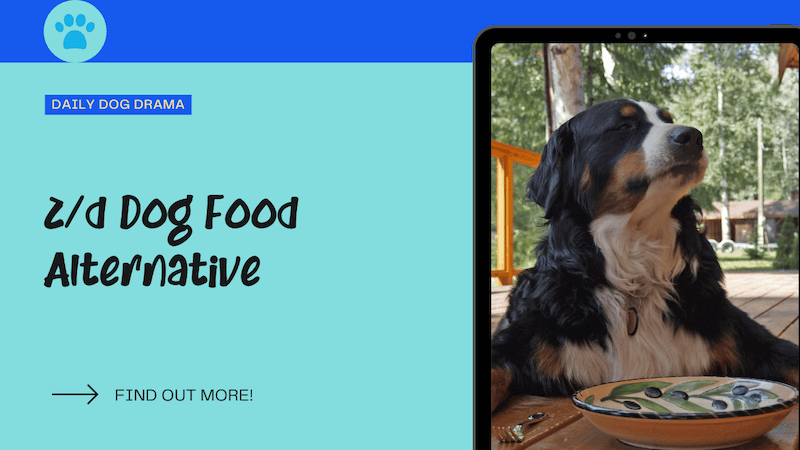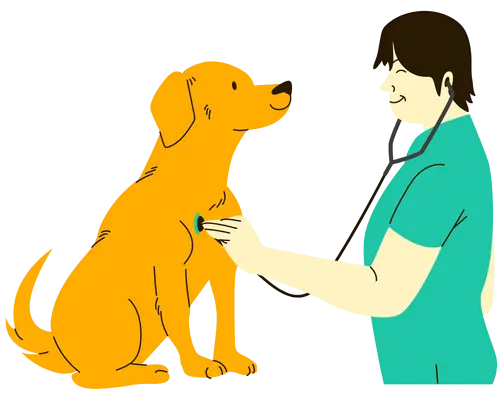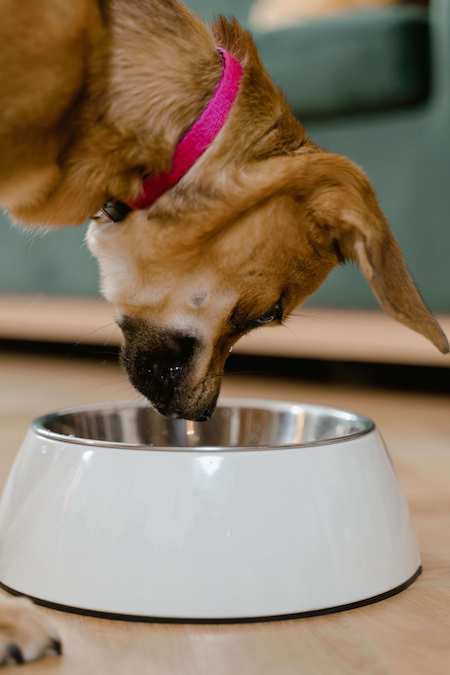Do you know what DOG ESSENTIALS you are missing out? Find out now!
Zack Keithy, our author, is a certified veterinarian technician (UC Blue Ash) for over 6 years (contact him here). The articles written here are based on his expertise and experience, combined with a review by our expert vet reviewers including Dr M. Tarantino. Learn more about us here.
z/d Dry Dog Food is a well-known brand of prescription pet food from Hill’s Pet Nutrition that has been on the market for decades.
However, some dog owners are concerned about the quality of the ingredients used in this range, and how these ingredients affect their pets, not to mention that they can get quite expensive too.
If you want to know what dog kibble is comparable to Science diet zd, or you’re looking to avoid them because of concerns over their reliability and quality, or seeking a cheaper option, we have good news: there are 3 excellent z/d dog food alternatives available.
Learn about them in this post and a bunch of useful tips about dealing with a dog with food intolerances and allergies.
Medical Questions? Talk to a Veterinarian 24/7.
Connect one-on-one with a licensed vet who will answer your questions in minutes.
*Article may contain affiliate links to retailers like Amazon and Chewy. Learn more on our disclosure page.
- Best Alternatives to z/d Dog Food
- What is Hydrolyzed Protein Dog Food?
- What is Hill's Science Prescription Diet z/d?
- What are the Ingredients in z/d Dog Food?
- Hill's ZD Dog Food Side Effects
- Signs of Food Allergies and Sensitivities in Dogs
- What to do if Your Dog is Allergic?
- What Kind of Diet is Suitable For Your Dog?
- How to Transition Your Dog to a New Diet?
- Don't Forget Fresh Fruits and Vegetables
- How to Choose Food for Sensitive Dogs
- In Conclusion: Hills ZD Dog Food Alternatives
Best Alternatives to z/d Dog Food

In the sections below, you will find a few other excellent dog food brands when it comes to a specialized diet for your dog with unique needs.
They are very similar to z/d dog food in terms of their ingredients and the problems they are aiming to solve, which are food sensitivities and skin problems.
Take note: You will need a vet’s authorization before you can purchase these foods.
Here’s a quick overview before you read on:
- Cheaper Alternative to Hills Science Diet: Blue Buffalo Natural Veterinary Diet
- Best for Picky Eaters: Purina Pro Plan Veterinary Diets HA Hydrolyzed Wet Dog Food
- Best Grain-Free Alternative: Royal Canin Veterinary Diet Adult Hydrolyzed Protein HP Dry Dog Food
1. Blue Buffalo Natural Veterinary Diet HF Hydrolyzed for Food Intolerance Grain-Free Dry Dog Food
Key Benefits
- Provide your sensitive dog with the nourishment she requires while still giving her the taste she enjoys
- Made with hydrolyzed salmon, which is a digestible protein source, as well as fish oil and flaxseed, providing nutritious omega-3 fatty acids that support healthy skin and a lustrous coat
- Grain-free and high in antioxidants, which help to maintain a healthy immune system
2. Purina Pro Plan Veterinary Diets HA Hydrolyzed Chicken Flavor Dry Dog Food
Key Benefits
3. Royal Canin Canine Ultamino
Key Benefits
- Clinically proven to help reduce skin reactions that may be due to sensitivities to common proteins found in pet foods
- Minimizes the risk of reaction with proteins extensively broken down to a size that’s virtually unrecognizable by the immune system
- Reinforces the skin barrier with specific nutrients to support healthy skin in dogs with skin sensitivity and irritation
What is Hydrolyzed Protein Dog Food?
Protein is an essential part of any diet that makes up your dog’s muscles, hormones, and disease-fighting antibodies.
They get proteins from food, break them down into building blocks known as amino acids, and then combine those amino acids to form new proteins.
The thing is, dietary proteins can sometimes cause an adverse immunological response in some animals.
So proteins are chemically broken down into little fragments by hydrolysis so that the immune system no longer reacts to them.
Hydrolyzed protein dog meals are commonly prescribed by veterinarians to address two conditions in dogs: food allergies and inflammatory bowel disease.
The protein in hydrolyzed dog food has undergone a process called hydrolysis, which breaks down the protein molecules into smaller fragments or peptides.
The purpose of this process is to reduce its allergenicity, which means a dog’s immune system is less likely to recognize them as allergens, reducing the chances of an allergic reaction.
Doggy says, read this next: Canidae vs Natural Balance Dog Food: Which to Choose?
What is Hill’s Science Prescription Diet z/d?
The prescription diet z/d, which uses highly hydrolyzed animal protein and various carbohydrate sources, was formulated by Hill’s nutritionists and veterinarians to support your dog’s skin and food allergies.
Gluten, soy protein, and lactose are among the protein sources that some dog breeds find unacceptable, which are all omitted from the formulation of z/d.
Not only that, the specially created recipe contains a high amount of anti-oxidants, fatty acids, and other nutrients that are important for a dog’s nutritional needs.
You see, food sensitivities and intolerances are potentially dangerous conditions that can cause sensitive or irritated skin, coats, and ears.
They are known to also cause stomach-related issues that are distressing to dogs and are characterized by an adverse response to the protein in the food.
So, this range of holistic dog food was created to solve these particular issues.
Hill’s also has other products to tackle issues such as urinary care (c/d), weight management (j/d), kidney care (k/d), digestive care (i/d), and one that is multi-benefit (w/d).
What are the Ingredients in z/d Dog Food?
This list was extracted directly from the manufacturer:
| Corn Starch | Hydrolyzed Chicken Liver |
| Soybean Oil | Powdered Cellulose |
| Calcium Carbonate | Dicalcium Phosphate |
| Lactic Acid | Potassium Chloride |
| Glyceryl Monostearate | Choline Chloride |
| Iodized Salt | Vitamins (Vitamin E Supplement, L-Ascorbyl-2-Polyphosphate (source of Vitamin C) |
| Niacin Supplement | Thiamine Mononitrate |
| Vitamin A Supplement | Calcium Pantothenate |
| Biotin | Vitamin B12 Supplement |
| Pyridoxine Hydrochloride | Riboflavin Supplement |
| Folic Acid | Vitamin D3 Supplement |
| DL-Methionine | Minerals (Ferrous Sulfate, Zinc Oxide, Copper Sulfate, Manganous Oxide, Calcium Iodate, Sodium Selenite) |
| Taurine | Mixed Tocopherols for freshness |
| Natural Flavors | Beta-Carotene |
Hill’s ZD Dog Food Side Effects
Quick note: The United States Food and Drug Administration (FDA) in 2019 investigated the occurrence of possibly dangerous vitamin D levels in some of their food following consumer concerns. Hill’s had to recall some of their canned food after the investigation and the Z/D range of canned food was also named among them. The recall has since been terminated.
When a dog is overexposed to Vitamin D, there can be a number of nasty side effects, namely:
- Weight loss
- Loss of appetite
- Kidney failure
- Vomit
- Diarrhea
- Joint issues
- Bradycardia/high blood rate
- Drooling
- Renal failure
- Death
The ZD Dog Food recall has led to widespread concern over the health of dogs who’s eaten it, and some have chosen to avoid feeding it to their dogs due to this concern.
Signs of Food Allergies and Sensitivities in Dogs

The most common symptoms of a food allergy include itchy skin, paws, or ears, as well as digestive issues like vomiting or diarrhea.
Hyperactivity, weight loss, a lack of vitality, and even hostility are some of the more subtle changes that might take place.
It’s important to note that allergies can be caused by a variety of factors.
While food allergies are one common cause, there are many more.
If your dog has a reaction to z/d food right after consuming it, then it could very well be due to the ingredients found in the food.
For example, some dogs have a sensitivity to beef or chicken that causes them to break out in hives when they eat those products.
In this case, switching to a different brand of dog food may help alleviate your pet’s symptoms.
Zd has been called out for using low-quality ingredients and failing to list their full ingredient lists on their packaging – a problem because it makes it difficult for consumers like you or me to find an alternative if we’re unsatisfied with Z/D’s products.
Hey there, sorry to interrupt but I wanted to tell you about an online vet service I’ve been using for years.
An in-person visit with one is great, but it’s not always an option.
Now, thanks to technology, you can speak to one without leaving your home.

Got something to ask a vet?
Talk to one anytime, 24/7.
* Don’t use this service for emergencies.
Alternatively, a vet can come out to you instead (exclusive to our readers: use THEVETS15 for 15% off).
SCHEDULE AN APPOINTMENT HEREThank you. The rest of the article continues below.
What to do if Your Dog is Allergic?
If your dog is experiencing any kind of allergic reaction, contact your veterinarian immediately or consider getting a nutrition consultation.
While it’s not uncommon for dogs to experience some kind of reaction to something they eat, if you suspect that the ZD has triggered a severe allergic reaction in your pet, try switching him out of the brand and onto another brand.
It could be that your dog is having a negative response to one or more of the ingredients found in his food.
Identifying Allergic Reactions
Allergic reactions aren’t necessarily easy to identify when they’re happening; however, there are some warning signs you can look out for that might indicate an allergic reaction:
- sudden scratching or itching on their body
- redness around their eyes
- excessive drooling
- vomiting or diarrhea
- hives (small bumps)
- swelling around their paws and feet
What Kind of Diet is Suitable For Your Dog?
A dog’s diet depends very much on its age (life stages), breed, and activity level. Here are a few key points you should be aware of:
- Puppies and senior dogs need different amounts of food: Consider the puppy phase as a time to build muscle and bone mass. You’ll want to make sure your pup’s caloric intake is high during this time. As a very rough guide, you should feed your puppy around 4 times a day (and only puppy food), while 2 feedings is sufficient for an adult dog.
- Active dogs need more calories than sedentary ones: If your pup is super active or has a very fast metabolism (called hyperthyroidism), then it’s important that you increase its calorie count even further so it can get enough energy to keep up — this means feeding it four times instead of two! If you’re not sure whether or not your pet is getting enough exercise, then talk with your veterinarian about what kinds of exercises they should do together each day so they burn off extra calories before storing them as fat deposits instead (which could lead down an unhealthy path).
- Breeds may also require special diets due to their natural size/build type: Certain breeds have been bred over centuries towards certain traits such as weight gain potential; therefore dogs within these groups may require specialized diets tailored specifically for their genetic predisposition towards obesity which could otherwise lead them down dangerous paths later on in life.
How to Transition Your Dog to a New Diet?

Before you do so, take note that a sudden change in your dog’s diet may result in gastrointestinal distress, including nausea, diarrhea, and a loss of appetite.
Every time you make the decision to switch your dog’s food, you should gradually introduce the new diet to give your dog’s body time to get used to the change.
These adjustments ought to take place over the course of 5-7 days.
You will progressively include more and more of the new food by combining it with your dog’s current diet during this transition.
Learn more here.
Don’t Forget Fresh Fruits and Vegetables
Fruits and vegetables are also important components of a balanced diet for dogs.
They provide vitamins, minerals, and fiber that can be good for your dog’s teeth, digestive system, and overall health.
Here are some fruits and vegetables that you can provide for your dog:
- Fruits: Apples, bananas, berries, grapes (seedless), melons (cantaloupe and honeydew), oranges (seedless), peaches, pears
- Vegetables: Broccoli florets, Brussels sprouts, carrots, peas
How to Choose Food for Sensitive Dogs
There are several things you should look for when choosing an alternative to zd dog food.
The thing you should look for in good dog food is that it does not contain any filler ingredients, such as corn or wheat gluten, which are often used to increase the protein content in a product without increasing its cost.
Dog foods with high amounts of protein from fillers can cause digestive issues like diarrhea and vomiting in some dogs, especially those who have allergies or sensitivities to certain types of proteins like beef or chicken.
It’s also important that your dog’s food contains only whole grains; this means there should be no additives such as corn syrup solids or hydrogenated oils added during processing (corn syrup solids are used as an inexpensive sweetener).
If your chosen brand contains these fillers then you may end up feeding them unhealthy ingredients instead!
In Conclusion: Hills ZD Dog Food Alternatives
This post provides you with a few great alternatives to Hill’s z/d dog food without sacrificing any quality, and in some cases, might be more wallet-friendly.
Don’t forget to check in with your vet first as they do require authorization before you can buy them.
Choosing the right food can be confusing for any dog owner, which is why we have written many articles about dog diets and different brands such as the Good Friends dog food review, Blue Buffalo vs Fromm dog food, Purina Pro Plan vs Acana, and many more.
Don’t forget to check them out too!
You’ve made it to the end, but I hope it’s not the end of our journey. We want to hear your voice! Share your thoughts, problems, suggestions, or anything related to your dog in the comments section. And don’t forget to join our newsletter today too.






